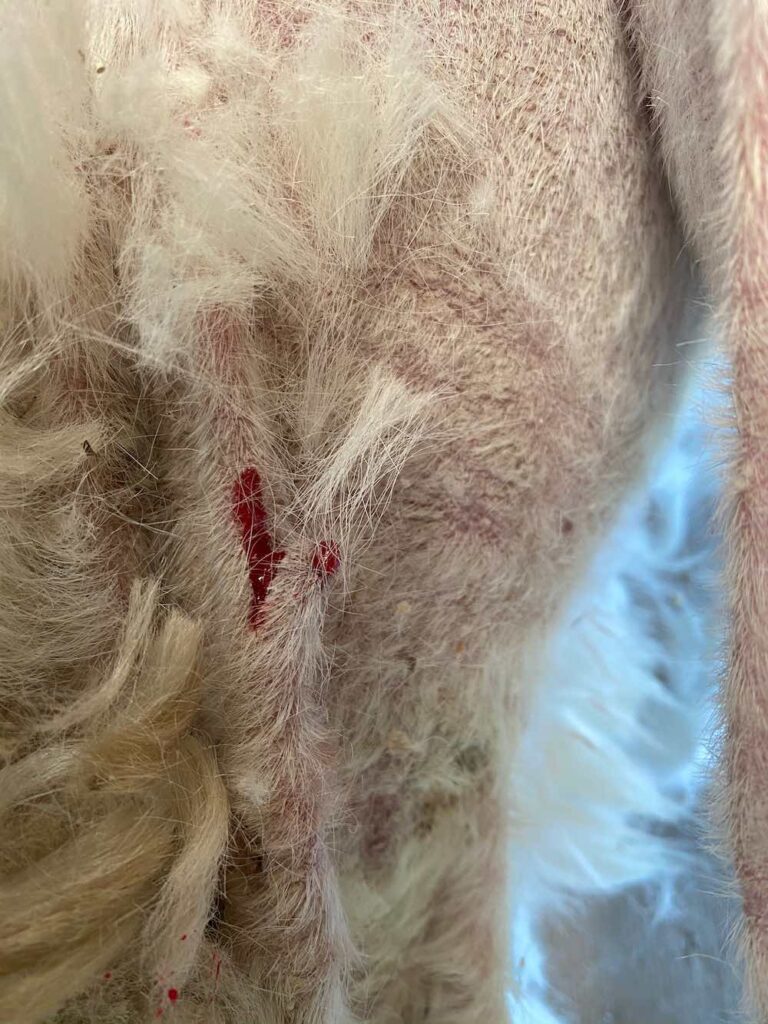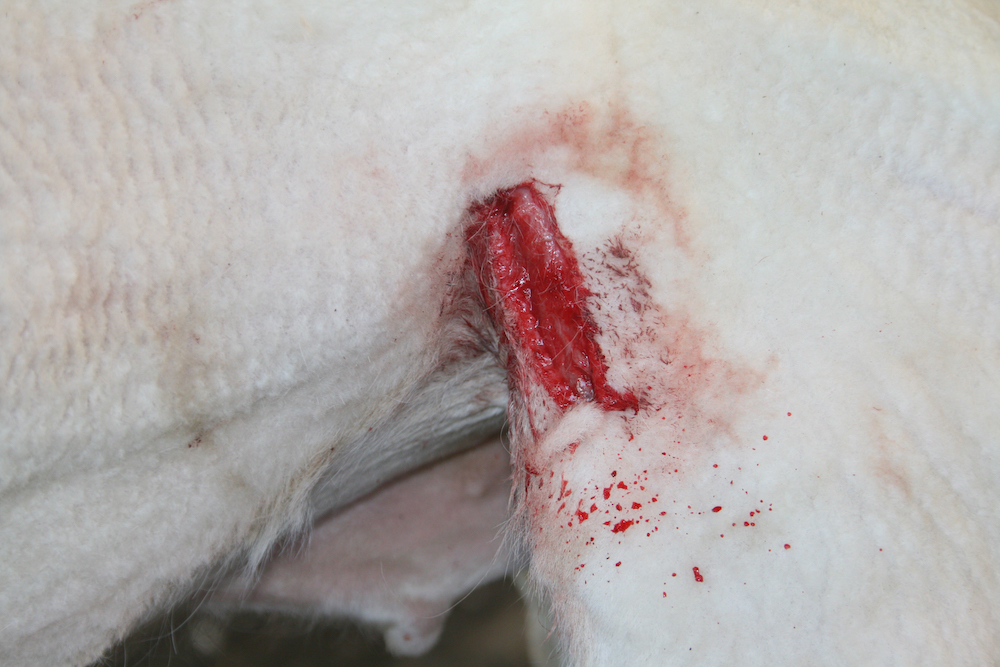At shearing time, occasionally wounds may arise due to clipper injuries. Fortunately, most of these are small knicks in the skin that can be cleaned and have a little wound spray applied. However, some wounds may require a little more care in order to bring the edges together so that they heal better: tissue glue can be used for some of these wounds, once they have been cleaned and are dry. Tissue glue can be useful for small wounds, mostly those that don’t gape open and that the edges naturally want to sit opposed. The wound edges do have to be held together for about 30 seconds and it won’t work if the edges are still bleeding. You don’t really want to use tissue glue without first cleaning the wound because the glues provide a waterproof seal and you don’t want to seal infection in the wound.


LEFT: The wound on the left is an inverted V, about an inch in length, and the skin is hanging down and off to the side slightly. After cleaning and removing any loose hair, this wound may be amenable to use of tissue glue. Suturing would achieve a slightly better cosmetic result, but either would heal better than leaving untreated.
ABOVE: The wound above is located at the top of the left thigh, where the skin of the leg joins the body. This is a fairly classic location for clipper injuries. This wound is about 3 inches long and gaping open. The wound edges are around an inch apart. This wound requires suturing. Tissue glue will struggle to hold these wound edges together.
Larger wounds may need to be sutured together because with larger defects, the skin doesn’t want to remain in position and pulls apart more easily. If you have large wounds, you will need to get your vet to come and suture these for you. It’s best to get these sutured within 6-8 hours because wounds become infected. (If you’re tempted to go the DIY route, just remember that every new hole poked with a non-sterile needle has the potential to increase the chance of infection in the wound, and that the surgical needles your vet will use are super sharp which will make it easier to place the needle through the skin and will hurt a lot less!)
People sometimes think that they can use superglue (eg Loctite or Gorilla Superglue) to deal with these sort of wounds because it’s cheap and easy to get. While it may work, it’s useful to think about what is going on in the wound and what the animal might be feeling if you are tempted to use products that were not designed for use in tissues…
Superglue contains cyanoacrylate adhesives, usually methyl-2-cyanoacrylate. This provokes acute and chronic tissue reactions. They are toxic to tissues due to the heat produced when the chemicals polymerise and due to the high concentrations of breakdown products of the process that are produced locally, including formaldehyde and alkylcyanoacetate.
Because of the usefulness of superglue, but the toxicity of the regular glue to the sensitive tissues of the skin, tissue glues were developed especially for use on skin wounds. These are similar but use monomers that have longer alkyl chains that degrade more slowly and cause less toxicity in the tissues. They can be used for closing wounds without sutures, and because they provide a waterproof antimicrobial barrier, they promote epithelialisation and wound healing so can be used as dressings for burns, cuts, abrasions and mouth ulcers. They are much more expensive to produce which is why they are more expensive to buy.
On a forum post on Quora, Chad Varner wrote: “regular superglue burns like a mad b**tard…” So, if you’re tempted to use the cheap stuff on your animals, stop for just a moment first, and consider if you’d like it pasted into a wound without any warning…!
Tissue glues are available over the counter. Here are a couple of examples:
- Animus Medbond Skin Glue is one that I have used. Each vial comes with 10 applicator tubes so that it can be used multiple times – you won’t reuse them because the tubes seal with the glue! Available on our website here (at £21.21 +VAT Special offer price for April 2025), or purchase from £24.95 from Amazon (updated April 2025). https://amzn.to/3vKpSZS
- Liquid Skin is an alternative product that is a lot cheaper at £7.499 for 2 pipettes (also on Amazon, updated April 2025). I have used it on human skin where I think it is better for coating small cuts, abrasions and rubbed areas of skin to aid in healing, than for gluing deep cuts but you can always try it and see! https://amzn.to/3xJtewQ
The links above will take you to the product page on Amazon.co.uk. As an Amazon Associate I earn from qualifying purchases – essentially, if you pay after following this link, it won’t cost you any more, but Amazon gets a tiny bit less and I get a tiny percentage for letting you know about the product! Seems fair to me…hopefully it seems fair to you too!
